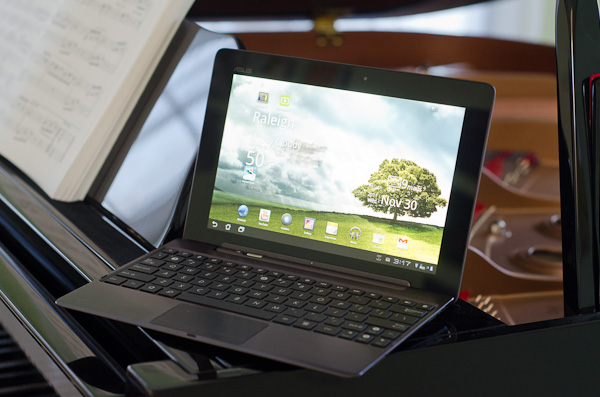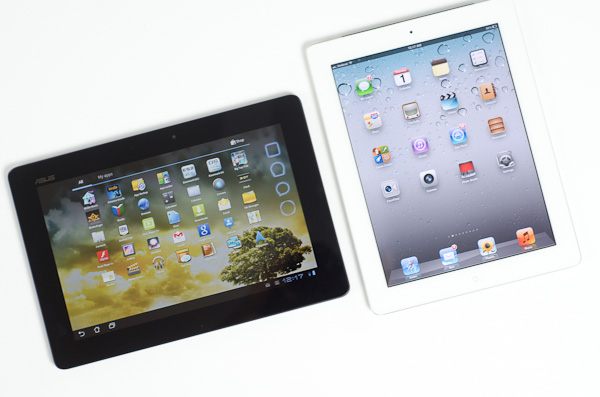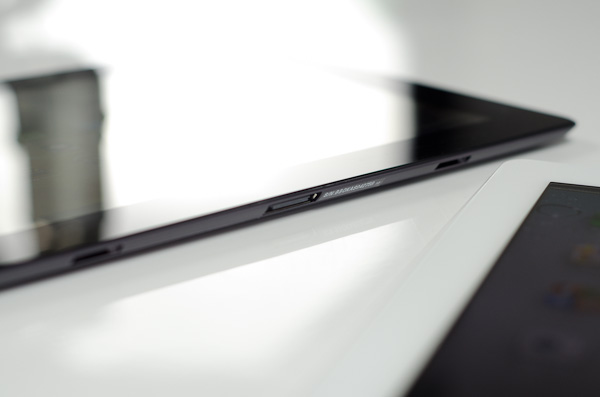ASUS Eee Pad Transformer Prime & NVIDIA Tegra 3 Review
by Anand Lal Shimpi on December 1, 2011 1:00 AM ESTGoing from making good motherboards to going head to head with Samsung for Google's affection is a pretty big step for ASUS, but it's one that the company has taken and done very well with. None of its peers have made the same transition, especially not while continuing to thrive in their existing businesses. I don't think anyone can say that ASUS' motherboards have suffered over the past several years as the company has transitioned, much like Apple, into the world of being a mobile computer manufacturer.
ASUS' first Android tablet was a knock out of the park. The original Eee Pad Transformer gave us a glimpse of the future with its keyboard dock while delivering a good Honeycomb experience for $100 less than the competition. As many sacrifices as ASUS had to make to reach its price point, the original Eee Pad remains one of the best Honeycomb tablets on the market. But the show must go on and simply being the cheapest on the block doesn't work anymore, particularly with companies like Amazon redefining what cheap means. It was time for a new flagship and today we have that tablet:
Priced at $499 the Eee Pad Transformer Prime will be available in North America during the week of 12/19.
| Tablet Specification Comparison | ||||||
| ASUS Eee Pad Transformer | ASUS Eee Pad Transformer Prime | Apple iPad 2 | Samsung Galaxy Tab 10.1 | |||
| Dimensions | 271mm x 175mm x 12.95mm | 263 x 180.8 x 8.3mm | 241.2 x 185.7 x 8.8mm | 256.6 x 172.9 x 8.6mm | ||
| Display | 10.1-inch 1280 x 800 | 10.1-inch 1280 x 800 Super IPS+ | 9.7-inch 1024 x 768 IPS | 10.1-inch 1280 x 800 PLS | ||
| Weight | 675g | 586g | 601g | 565g | ||
| Processor | 1GHz NVIDIA Tegra 2 (2 x Cortex A9) | 1.3GHz NVIDIA Tegra 3 (4 x Cortex A9) | 1GHz Apple A5 (2 x Cortex A9) | 1GHz NVIDIA Tegra 2 (2 x Cortex A9) | ||
| Memory | 1GB | 1GB | 512MB | 1GB | ||
| Storage | 16GB + microSD card | 32GB/64GB + microSD slot | 16GB | 16GB | ||
| Pricing | $399 | $499/$599 | $499 | $499 | ||
Whereas Motorola was first out of the gate with a Tegra 2 based Honeycomb tablet, ASUS is done with playing second fiddle. ASUS is NVIDIA's first and only launch partner for its new quad-core Tegra 3 SoC. The Google OS of choice is still Honeycomb, although I hear the Eee Pad Transformer Prime also happens to be Google's development and validation vehicle for Ice Cream Sandwich on Tegra 3.
The Prime is everything the original Eee Pad Transformer was missing. It's thinner than an iPad 2 or Galaxy Tab and built out of aluminum and glass. Other than minor details like the buttons and connectors, your hands never touch plastic when using the Transformer Prime. Even those plastic buttons look and feel great. The tablet is just beautiful. It echoes the design language of ASUS' Zenbook, but without the disappointment in the panel department. ASUS' latest tablet actually has the best display of any tablet we've reviewed, including those made by Apple and Samsung (more on this later).
The usual suspects are carefully placed around the perimeter of the Transformer Prime. Held in landscape mode the power/lock button is at the top left corner, with the volume rocker perpendicular to and just below it on the left side. Also along the left side is a micro HDMI output for display cloning and a microSD card slot. A standard 1/8" headset jack finds itself on the right side of the tablet, and ASUS' standard dock connector is bottom center. The original Eee Pad had two speaker grills, while the Prime has a single, larger speaker on the back of the device. Audio output is surprisingly full but the tablet doesn't get loud enough to overpower a noisy environment.
ASUS went a little crazy with the rubber stoppers all over the Prime. The dock connector and its two mechanical retention/secure points are plugged with these things, as is the USB port on the optional transformer dock.
Just like last time, the Eee Pad Transformer Prime can be mated to an optional keyboard dock for an extra $149. The dock adds a QWERTY keyboard, trackpad, an SD card reader, USB port and comes with its own 22Wh battery. The dock's battery not only powers itself but it can charge the Prime's battery, almost doubling battery life.
We'll spend the next several pages going through every detail of the new Eee Pad Transformer Prime as well as NVIDIA's Tegra 3 SoC, but on the surface, ASUS has built a formidable tablet. How does it fare under closer scrutiny? Very well it turns out...
A Lesson in How Not to Launch a Product
Of all of the things ASUS has learned from running the PC side of its business it seems that the proper way to launch a brand new platform didn't translate over to its tablet business. I received the Eee Pad Transformer Prime 39 hours ago and the NDA lifted just now. While this is not atypical for many mobile launches, ASUS should know better.
To do a thorough review of any product the minimum time we need to adequately integrate that product into our daily routine and come away with a deep understanding of the product is at least a week. I say that's the minimum amount of time because if you give us more, then we can do even better analysis and spend even more time bug hunting. Most of the players in the mobile space don't really get this, and as a result they are complicit in the disappointing amount of analysis that's done on their hardware. This will change as time goes on, but I honestly expected more from ASUS.
My WiFi is Broken
What's one of the biggest risks when you give reviewers only 39 hours to review a product? If something is wrong with the review sample, there's hardly any time to fix it. This time I drew the short straw and my Transformer Prime review sample arrived with highly questionable WiFi performance. Both range and performance were impacted by whatever plagued my sample. I got less range and much lower performance than the original Eee Pad Transformer regardless of location or wireless access point. How bad? My Prime had difficulty sustaining more than 2Mbps over WiFi. ASUS and NVIDIA both sent me proof that there wasn't something wrong with other samples, and from their data it looks like the WiFi stack in the Prime is at least comparable to the original Transformer. The problem may just be limited to my unit, although I tend to believe that if something goes wrong once, it's bound to go wrong more than once.
Based on the fact that wireless performance improves when docked and upstream speeds are almost normal, if I had to guess I'd say that the receive antenna is either not fully connected or somehow impaired from doing its normal duty. I should have a replacement unit in by tomorrow, but unfortunately that means you won't see any WiFi dependent results here.
ASUS chose Broadcom's BCM4329 for WiFi/Bluetooth duty. Although the controller supports both 2.4GHz and 5GHz operation, the Prime is limited to work on 2.4GHz networks. The rest of the design is pretty standard - you get a single spatial stream at a maximum of 72Mbps. Real world performance, if ASUS/NVIDIA's numbers are to be believed, should top out somewhere in the upper 30Mbps area.
Update: ASUS got us a fixed unit, be sure to check out our follow-up here.




















204 Comments
View All Comments
MiSoFine - Thursday, December 1, 2011 - link
I had a TF 101 & used a cheap USB mouse & worked just fine--better than the touch pad in some instances; with my wireless printer I was able to print documents with ease. Didn't try the game pad--don't game. Might borrow an XBox to test with my preordered TF 201.Sanz84 - Thursday, December 1, 2011 - link
Android natively supports flash disks, usb external drives or devices and game controllers such xbox or ps3 wireless controllers - no need for third party apps. For the galaxy s2 you just need a cheap micro usb - female usb connector for exampleSanz84 - Thursday, December 1, 2011 - link
Great job with the review. However, I'd like to point out how many people are losing perception of what a portable computing device should be for, especially for the masses. On too many sites (not here ofc) I saw reviews like: not unleashing all the power like iOS does; such phrases start to become embarassing and I'll explain why. Sorry if I'm derailing a bit, still will describe the Asus Prime even if not mentioning it.Common users take such devices - mostly- for web browsing, video viewing, music listening, connectivity and file management.
Granted, I'd like to know in which of any of these fields is iOS such a beast.
Web browsing - performance wise is quite good, ics browser showed up superiority anyway; incomplete experience without flash: no video streams from many sites, incomplete facebook feeling without addons, no 1080p youtube (correct me if I'm wrong)
Video viewing: native player does not support popular containers such .mkv, paid apps not so smooth on 1080p? Video upload only via itunes, need to have fun with video converting.
Music listening: converts audio library to m4a format, hard times if you want to add a single song from a different terminal
Connectivity: no bluetooth file transfer, no wifi transfer outside itunes (on android can browse the device with w7 explorer), no usb, no sd.
File management: guess.
This said, why would an adult individual prefer an iOs tablet over the Prime? Why many reviewers take as normal the lack of file management and connectivity? If the iPad goes insane, you still need another device to recover it. It's not indipendent, but the Prime on its way, it is.
The Prime with ics will be a big step forward into mobile computing and will be completed when win8 and x86 will be in game aswell. For me the iPad is a toy with a drawn apple that is great in mobile gaming. (can use external controllers tough?)
Sorry for the wall of text and correct if I'm wrong :)
Icehawk - Thursday, December 1, 2011 - link
As an iPad owner and daily user who is a dedicated PC owner, gamer, and a prior IT admin for 10yrs, here is my reply:First it all comes down to usage IMO. I have an iPhone & PC, and aTV too. What I find myself using the iPad for is the following: gaming, reading books, and acting as a go-between for my PC share and my aTV/stereo. When I'm in the living room and we want to fact check, IMDB, etc I find myself reaching for my phone if it is closer because on neither do I want to do more than a quick look - I do not find either enjoyable mediums for "real" browsing. I like to play so-called casual games while I'm listening to podcasts, radio shows, audiobooks and the like and the iPad is great for that IMO. I have a large, diverse library - I use Airplay and apps like Airvideo to bridge the gaps between devices in my home and find it pretty simple. What I don't do is any real work, any browsing of multiple pages/any length, and obviously more in-depth games like Skyrim need to be played on an actual computer. Oddly I have been using my iPad to do video editing even though it's probably easier on my PC.
Regarding your specific points:
Web Browsing - I use this exclusively for a quick browse - usually looking something up on iMDB, checking a TV schedule, etc so Flash isn't usally an issue unless, for example, a restaurant uses a Flash splashpage. Keep in mind I watch little online content in Flash format in any event so YMMV. Do I agree with Apple, no, but for me it isn't a deal breaker by any means.
1080p, yup none of that but it's not a huge deal honestly - yes, I'd like it but you can't have everything and visual quality is good enough I can give up a little here. Maybe next time.
Music - I don't have any m4a files mine is all MP3 and that isn't an issue. Yes, you do have to use iTunes and it still sucks monkey testicles and that in my mind is the real problem with any iDevice. iTunes pretty much chokes on my 200gb of music. The reality is though that I can either stream music from Spotify, et al or from my PC share most of the time, for trips away I can suffer through loading music on it or my phone.
Connectivity - I can't disagree although it really isn't a huge deal for the most part. A lot of apps support file transfers btw seperate from iTunes or via iTunes without a sync. You do get AirPlay which works awesome most of the time and allows video & audio streaming. Regarding file transfer see my next comment.
File System - ok, w/o a jailbreak you are fairly limited no doubt. If you DO JB, and you will if there is one available, you can install one simple file and then use a million different programs to browse the file system and even transfer files. I do wish iOS supported pure drag & drop though, trust me!
Basically the things a lot of non-tablet owners think are an issue are not because it just doesn't fit the way you end up using them. IMO, YMMV, etc but this has been my experience ever since I got the iPad on release day. Where I find it to be the best damned thing I've owned is on flights - toss a few movies, ebooks, etc on there and I'm a happier camper.
Icehawk - Thursday, December 1, 2011 - link
One more thing - you said if the iPad goes insane you need another device to fix it. I don't know about Android but one thing I LOVE about iOS is that it is virtually impossible to brick them. Plug them into a PC/Mac and there is always a way to restore it.metafor - Thursday, December 1, 2011 - link
True but having had an iPhone for 3 years and having to restore from backup a few times, it's ultra-annoying to lose everything that happened between your last backup.I don't know that it's really possible to "brick" an Android device to the point where you need to restore from backup. I suspect this is just Apple being more conservative with the internal state of their device.
steven75 - Saturday, December 3, 2011 - link
With iCloud, backups are wireless on wifi and happen automatically every couple days. How much can you really lose in that time considering many apps themselves now backup to iCloud on their own?Sanz84 - Friday, December 2, 2011 - link
On android you can backup your data let's say on an external sd or usb flash disk and restore factory settings on the go (reinstalls the os basically). No need to plug the device to the pc. My iphone went nuts at least two times and couldn't call until I recovered it via itunes. On my sgs2 just restored factory defaults in few minutes and I was able to call.steven75 - Saturday, December 3, 2011 - link
That's no longer the case on iOS 5.vvk - Thursday, December 1, 2011 - link
iOS works seems to work better for none techie people. My parents are happy with their Ipad 2 (there was nothing better in May 2011 but my grandma is getting Android tablet for X-mas :)I personally feel like I am wearing straitjacket whenever I have to use iOS and the game of cat and mouse with the jailbreak gets tiring at some point. However, where I find restraints other people find support - humans are strange :)